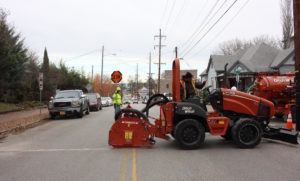
[asset-audio[{“description”: “Hear the radio version of this story.”, “fid”: “33956”, “uri”: “npraudio://201712/1712xx_microtrenching.mp3”}]]
Google Fiber has dramatically shifted its construction technique for bringing its high-speed internet option to Nashville. While fighting for access to utility poles had spawned an epic legal battle, the company and city officials are finding satisfaction with a method known as “microtrenching.”
Since October, several neighborhoods have been seeing crews use large circular saws, often attached to Ditch Witch tractors, cutting grooves into the asphalt — an inch wide, and at least 4 inches deep. The cable is run inside and covered with foam and quick-dry concrete.
The method is loud and briefly disrupts street parking. But in many ways, it has become a much-preferred alternative.
“The speed at which they can do this — it’s probably tenfold,” said Rick Kirkpatrick, head of permitting for Metro Public Works.
He said that once Google Fiber pitched the idea and temporary rules were in place, the company has pulled more than 1,200 microtrenching excavation permits in roughly two months.
The prior options were fraught. Attaching to utility poles — and a proposal known as “one touch make ready” to expedite the process — triggered a lawsuit that has embroiled telecom companies and the city.
 Tony Gonzalez WPLN News
Tony Gonzalez WPLN NewsMicrotrenching is loud and disrupts street parking, but Google Fiber and Metro Public Works say it has a much lower impact than deep digging.
And deep digging has caused more than 100 instances of underground water utility damage since August 2015 — damage estimated at more than $700,000, according to Metro Water Services. (The tally includes all fiber installations by all companies, and was provided to WPLN this week. For more on damage estimates, revisit this story about the tabulation).
In contrast, Kirkpatrick calls microtrenching “low-impact” — it’s a shallow cut that avoids utilities, leaves sidewalks intact, and doesn’t interfere with road repaving.
“The critical part is we’re conscious of the road, what it’s doing to the road, the longevity of the road, and that’s why we have inspectors go out there and take a look at it,” he said.
So far, no other telecoms are doing this in Nashville. But Metro is writing a policy so they’d be ready for multiple microtrenches along the streets.
 Tony Gonzalez WPLN News
Tony Gonzalez WPLN NewsA microtrench is at least 4 inches deep — to avoid problems with repaving — and as narrow as a saw blade.

